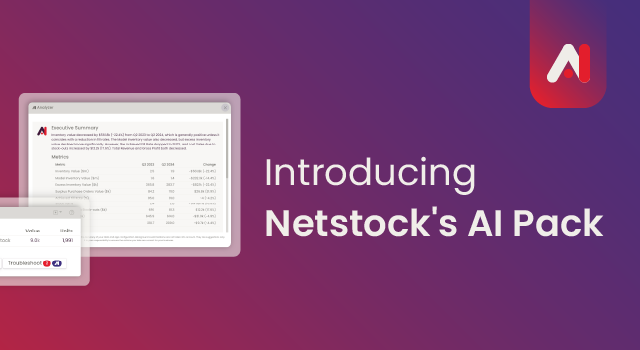Stay ahead of the competition in 2024 by mastering these essential inventory management techniques.
Table of contents:
1 Introduction
Effective inventory management is key to unlocking working capital and balancing supply and demand. As we head into 2024, the inventory management landscape is evolving rapidly, with businesses seeking more sophisticated inventory management techniques to streamline their processes. Let’s explore the fundamental concepts of inventory management and its benefits for SMBs and highlight six valuable inventory management techniques to navigate global challenges and enhance profitability.
2 What is inventory management?
Inventory management oversees the flow of goods from manufacturers to warehouses and ultimately to the point of sale. It involves monitoring and managing businesses stocked items to meet customer demand while reducing excess stock or minimizing stock-outs. By leveraging technology to help optimize inventory levels, businesses can work to improve their supply chain operations.
3 The benefits of inventory management for your business
Efficient inventory management is fundamental for all businesses holding inventory. It offers various benefits that can significantly affect your bottom line.
- Customer loyalty and satisfaction: Maintaining optimal inventory levels ensures the right products are available at the right time and location for your customers.
- Reduced costs: Inventory management can reduce inventory value and holding costs by preventing excess stock or stock-out scenarios.
- Minimize stock-outs: You will continue experiencing stock-outs or potential stock-outs on high-demand items if you don’t forecast accurately or maintain optimized inventory levels.
- Better inventory decision-making processes: Enhanced data from inventory management processes helps businesses make informed and data-driven inventory decisions. This includes identifying top-performing and the most profitable items and aligning your inventory management strategies with customer demand.
- Unlock cash: Is your inventory a liability or an asset? Reduce excess inventory to free up working capital to generate more revenue.
- Improve supplier performance and relationships: Successful and collaborative inventory management can help foster healthy supplier relationships. Measure and monitor your supplier performance so you can rapidly respond to changes in lead times.
4 How does current economic and global conditions impact inventory management?
The current business landscape is demanding, and businesses often face external disruptions. Global economic volatility and changes in demand and supply require businesses to adopt inventory management software to help weather the storm. According to a recent Netstock survey, “82% of respondents can’t quantify an ROI on their inventory management system – but they are still spending money.” Various factors like trade tensions, geopolitical uncertainties, and inflationary pressures create a ripple effect directly influencing the availability, the cost of items and how well a business can meet demand.
Businesses equipped with inventory management software can respond to rising inflation and interest rates by adjusting their pricing strategies, revisiting reorder points, and optimizing supplier relations and inventory levels to mitigate the impact on profit margins.
Agile inventory management software becomes a strategic asset, enabling businesses to survive and thrive amidst the uncertainties of the modern market.
5 Six Inventory management techniques to master in 2024
Let’s look at six essential inventory management techniques today.
- Demand forecasting: You should utilize advanced analytics to predict how much of each item is required to meet customer demand. This means leveraging historical data, market trends, and seasonality patterns to forecast demand. By analyzing historical sales performance data and identifying trends, businesses can anticipate future demand, adjust minimum order quantities, and reorder points. Inject predictability into your supply and demand process by predicting future outcomes of events and promotions, across products, customers, and categories.
- ABC analysis: ABC analysis is a strategic inventory management technique that categorizes items into three classes – A, B, and C – based on inventory value. It provides a dynamic framework for prioritizing inventory management efforts. Class A items, typically high-value products, receive closer monitoring and more frequent reviews, ensuring that resources are directed toward the most critical items. This approach enables businesses to allocate time, resources, and attention effectively, optimizing inventory management practices and improving overall operational efficiency.
- Minimum Order Quantities (MOQ): MOQs represent the minimum quantity of an item a supplier is willing to sell. Effectively managing MOQs is vital for maintaining cost efficiency and reducing excess stock. MOQ optimization involves analyzing supplier agreements, evaluating demand patterns, and aligning order quantities with actual requirements. By balancing meeting supplier criteria and avoiding unnecessary stockpiling, businesses can enhance cost-effectiveness, reduce holding costs, and ensure a more streamlined inventory management process.
- Safety stock management: Safety stock acts as a buffer to protect against unexpected fluctuations in demand or supply chain disruptions. Safety stock represents the extra inventory held beyond regular demand requirements to guard against uncertainties. Implementing a safety stock management strategy involves continuously monitoring demand patterns, supplier performance, and external factors that may impact the supply chain.
- Reordering formula Balancing the number of orders can be difficult as excessive demand may lead to the risk of obsolescence, while insufficient orders may result in stock-outs. With access to historical data, determining the optimal reorder points for your items should rely less on intuition and more on informed, data-driven insights.
- Inventory visibility: Real-time inventory visibility is essential for modern inventory management. By leveraging technology, businesses can monitor inventory levels across the supply chain in real-time. Netstock’s cloud-based platform provides a centralized dashboard that offers instant visibility into stock positions. This visibility allows businesses to track inventory movements, identify potential bottlenecks, and respond promptly to changes in demand or supply. Businesses can make informed decisions, improve their operations, and maintain optimal inventory levels by having a clear and up-to-date picture of their inventory.
6 How to improve your inventory management
- Embrace technology: By implementing the right inventory management software, inventory businesses can automate routine tasks, gain real-time insights into their supply and demand, focus on the items that need attention, and quickly increase their ROI.
- Regularly review and update inventory policies: The market is ever-changing, and so should your inventory policies. Businesses should maintain agility by consistently reviewing and updating inventory policies based on shifting supply and demand trends.
- Measure Key Performance Indicators (KPIs): As the supply chain becomes more unpredictable, it is essential to establish, assess, and gauge your inventory KPIs in order to effectively organize and plan your inventory.
- Staff training: A knowledgeable workforce ensures the seamless integration of inventory management solutions into daily operations. By investing in training and onboarding programs, businesses can empower their staff to navigate these tools effectively, maximizing their impact on overall efficiency and productivity.
7 Conclusion
Supply and demand volatility, especially amid global economic uncertainties, underscores businesses’ need to implement inventory management techniques.
Whether leveraging Netstock’s advanced algorithms for demand forecasting or using Netstock to automatically adjust your safety stock levels, the key is embracing innovation, fostering collaboration across your business and with your suppliers, and continuously refining strategies. Armed with these insights, take the next step in optimizing your inventory management practices and steering your business toward success in 2024 and beyond.








